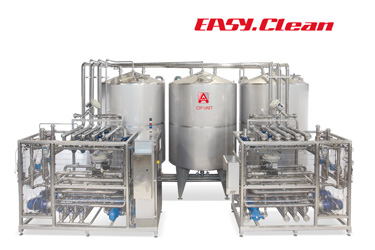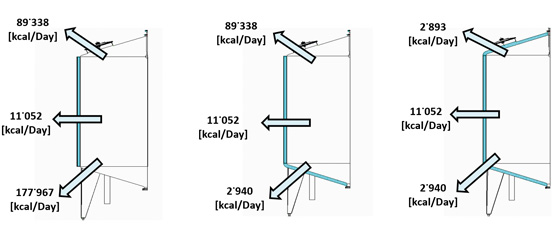 A DUE ottimizza i propri impianti di lavaggio EASY.Clean in un’ottica green per garantire la migliore efficacia possibile, nel minor tempo e con i minori consumi di acqua e di energia
A DUE ottimizza i propri impianti di lavaggio EASY.Clean in un’ottica green per garantire la migliore efficacia possibile, nel minor tempo e con i minori consumi di acqua e di energia
A DUE ha intrapreso una serie di studi e test per ottimizzare i propri impianti di lavaggio EASY.Clean in un’ottica eco-sostenibile, al fine di garantire la migliore efficacia possibile, nel minor tempo e con i minori consumi di acqua e di energia.
È possibile dimezzare il consumo energetico grazie ad un’opportuna coibentazione dei serbatoi per lo stoccaggio delle soluzioni di lavaggio mantenute in temperatura (coibentando anche il coperchio e il fondo del serbatoio). Il risparmio ottenuto in meno di 18 mesi compensa il maggior costo d’acquisto, senza contare la riduzione di CO2 emessa che si attesta, nel caso studiato, in circa 20 Ton/anno.
 Test sperimentali sulle tecnologie di risciacquo dei serbatoi hanno messo a confronto il lavaggio continuo e quello ad intermittenza (burst rinsing) e diversi dispositivi di lavaggio: divosfera statica, divosfera rotante e turbina rotante. L’uso della divosfera rotante o della turbina rotante rispetto alla divosfera fissa garantisce un risparmio dal 30% al 70% in termini sia di acqua che di tempo; nella peggiore delle ipotesi il payback period è di circa 1 anno per la divosfera rotante e di 3 anni per la turbina. Inoltre, durante alcune fasi di risciacquo è possibile utilizzare lavaggio ad intermittenza che garantisce un risparmio di tempo di circa il 50% e di acqua di risciacquo nell’ordine del 25%.
Test sperimentali sulle tecnologie di risciacquo dei serbatoi hanno messo a confronto il lavaggio continuo e quello ad intermittenza (burst rinsing) e diversi dispositivi di lavaggio: divosfera statica, divosfera rotante e turbina rotante. L’uso della divosfera rotante o della turbina rotante rispetto alla divosfera fissa garantisce un risparmio dal 30% al 70% in termini sia di acqua che di tempo; nella peggiore delle ipotesi il payback period è di circa 1 anno per la divosfera rotante e di 3 anni per la turbina. Inoltre, durante alcune fasi di risciacquo è possibile utilizzare lavaggio ad intermittenza che garantisce un risparmio di tempo di circa il 50% e di acqua di risciacquo nell’ordine del 25%.
Effettuati anche test per aumentare l’azione meccanica del lavaggio insufflando aria per creare maggior turbolenza.
Un nuovo design impianto, affiancando al serbatoio della soda caustica un secondo serbatoio con minore capacità, consente d’eseguire fasi di pulizia con differenti steps, temperature, tempistiche o chimici specifici, in funzione del diverso grado di sporco da rimuovere nelle varie parti di impianto, riducendo consumi e tempi di lavaggio.
In corso studi su prodotti chimici alternativi per la disinfezione dei serbatoi, fra cui l’ozono disciolto in acqua, che, non necessitando di una successiva fase di risciacquo, riuscirebbe a garantire un notevole risparmio di acqua, nonché una riduzione di costo chimici, stoccaggio e smaltimento degli stessi.
Altri aspetti affrontati da A DUE per l’ottimizzazione di EASY.Clean sono uno studio accurato del lay-out per diminuire la lunghezza dei tubi riducendo tempi, acqua, dispersione ed energia. Il tutto gestito da moderni software d’automazione che consentono anche il monitoraggio delle prestazioni dell’impianto tramite opportuni indicatori delle prestazioni chiave (KPI).+
EASY.Clean by A DUE: the eco & sustainable CIP unit
A DUE optimizes its EASY.Clean washing stations in a green perspective to ensure the best performance, in the shortest time and with the lowest water and energy consumption
A DUE has undertaken a number of studies and tests aimed at optimizing its EASY.Clean washing stations, with a view to the eco-sustainability in order to ensure the best possible performance, in the shortest time and with the lowest consumption of water and energy.
The energy consumption can be halved thanks to an appropriate thermal insulation of the tanks for the storage of the washing solutions kept at a temperature (by adding both lid and bottom insulation). The savings obtained offset the higher purchase cost in less than 18 months, not to mention the reduction of CO2 emissions which, in the case under study, is about 20 t/year.
Pilot tests on tank washing technologies compared continuous rinsing with burst rinsing and confronted different washing devices: static spray ball, rotary spray ball and rotary jet head.
The use of the rotary spray ball or rotary jet head compared to the static device guarantees savings from 30% to 70% in terms of both water and time; in the worst case, the payback period is about one year for the rotary spray ball and three years for the rotary jet head. Moreover, during some rinsing phases, the use of burst rinsing allows to halve the execution time and to save about 25% of water.
Tests were also carried out to enhance the mechanical washing performance through air blowing creating greater turbulence.
A new smart plant design, combining the caustic soda tank with a second minor capacity tank, allows to implement cleaning phases with different steps, temperatures, times or specific chemicals, depending on the degree of soiling to be removed in the various parts of the system, reducing consumption and washing times.
Studies are underway on alternative chemicals for tank disinfection, including water-dissolved ozone, that, requiring no further rinsing, would be able to ensure considerable water savings, as well as chemical purchase, storage and disposal costs reduction.
Other aspect addressed by A DUE for the optimization of EASY.Clean is an in-depth study of the lay-out to reduce pipe lengths, thereby saving time, water, dispersion and energy. All managed by cutting-edge automation software that also allows the monitoring of plant performance through appropriate key performance indicators (KPI).









